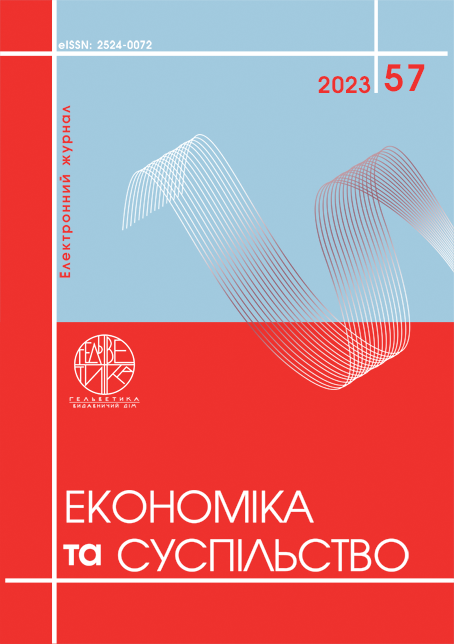НАУКОВЕ КАРТОГРАФУВАННЯ ДОСЛІДНИЦЬКОГО ПОЛЯ КОНКУРЕНТНИХ ПЕРЕВАГ РОЗВИТКУ ТЕРИТОРІЙ ЗА ДОПОМОГОЮ BIBLIOMETRIX R-PACKAGE
Анотація
У статті проведено дослідження наукової літератури, що стосується проблематики конкурентного розвитку територій. Основним інформаційним джерелом дослідження виступила наукометрична база даних Scopus, найбільша бази даних рецензованої літератури, за ключовими словами «конкурентна перевага», «територія», «регіон». Вибірка наукової літератури склала 566 документів. Період дослідження опублікованих документів з 1990 по 2023 роки. Були встановлені країни, що мають найбільшу кількість публікацій в розрізі конкретних університетів, а також найбільш цитовані публікації за вказаним напрямом. За результатами аналізу наукової літератури було встановлено, що існує чітка залежність між розвиток територій та його конкурентоспроможністю, оскільки забезпечення конкурентоспроможності є однією з основних цілей цього процесу.
Посилання
Flint, G. F. (2000), “What is the meaning of competitive advantage?”, Advances in Competitiveness Research, Vol. 8 No. 1, pp. 121–129.
Powell, T. C. (2001), “Competitive advantage: logical and philosophical considerations”, Strategic Management Journal, Vol. 22 No. 9, pp. 875–888. DOI: http://dx.doi.org/10.1002/smj.173
Lambin, J. J. (1997, January 1). Strategic Marketing Management. In-Text Citation: (Lambin, 1997). DOI: https://doi.org/10.1604/9780077092276
Grimm, C. M., Lee, H., Smith, K. G. (2006), Strategy as action. Competitive dynamics and competitive advantage, Oxford University Press, New York.
Wang, H. (2014). Theories for competitive advantage. In H. Hasan (Eds.), Being Practical with Theory: A Window into Business Research (pp. 33-43). Wollongong, Australia: THEORI.
Bain, J (1968), Industrial Organization, John Wiley and Sons, New York.
Evans, C (2003), Managing for Knowledge: HR’s Strategic Role, Butterworth-Heinemann, Amsterdam.
Hamel, G& Prahalad, C. (1994), Competing for the Future, Harvard University Press, Boston.
Beckmann, TJ (1999), ‘The current state of knowledge management’ , in J, Liebowitz, (ed.),Knowledge Management Handbook, CRC Press, Boca Raton, pp. 1–22.
Aria, M., & Cuccurullo, C. (2017, November). bibliometrix : An R-tool for comprehensive science mapping analysis. Journal of Informetrics, 11(4), 959–975. DOI: https://doi.org/10.1016/j.joi.2017.08.007
Zupic, I., & Čarter, T. (2014). Bibliometric Methods in Management and Organization. Organizational Research Methods, 18(3), 429–472. DOI: https://doi.org/10.1177/1094428114562629
Porter, M. E. (1990). The Competitive Advantage of Nations. Harvard Business Review, 68(2), 73–93.
Jardon, C. M., & Susana Martos, M. (2012, October 19). Intellectual capital as competitive advantage in emerging clusters in Latin America. Journal of Intellectual Capital, 13(4), 462–481. DOI: https://doi.org/10.1108/14691931211276098
Jardon, C. M. (2015, November). The use of intellectual capital to obtain competitive advantages in regional small and medium enterprises. Knowledge Management Research & Practice, 13(4), 486–496. DOI: https://doi.org/10.1057/kmrp.2014.4
Zen, A. C., Bittencourt, B. A., Hervas-Oliver, J. L., & Rojas-Alvarado, R. (2022, April 3). Sustainability-Oriented Transition in Clusters: A Multilevel Framework from Induction. Sustainability, 14(7), 4265. DOI: https://doi.org/10.3390/su14074265
Bittencourt, B. A., Zen, A. C., Schmidt, V., & Wegner, D. (2018, November 19). The orchestration process for emergence of clusters of innovation. Journal of Science and Technology Policy Management, 11(3), 277–290. DOI: https://doi.org/10.1108/jstpm-02-2018-0016
Pobirchenko, V., Shutaieva, E., Karlova, A., & Polyukhovich, E. (2019, December 31). Territory Brand: Approaches to Definition, Simulation Methodology. Journal of Environmental Management and Tourism, 10(6), 1351. DOI: https://doi.org/10.14505//jemt.v10.6(38).18
Shutaieva, E., Pobirchenko, V., Karlova, A., & Polyukhovich, E. (2020, June 30). Branding of Tourist Destinations. Journal of Environmental Management and Tourism, 11(4), 973. DOI: https://doi.org/10.14505//jemt.11.4(44).22
Qian, G., Liu, B., & Wang, Q. (2018, December 10). Government subsidies, state ownership, regulatory infrastructure, and the import of strategic resources. Multinational Business Review, 26(4), 319–336. DOI: https://doi.org/10.1108/mbr-10-2017-0080
Cham, T. H., Wei-Han Tan, G., Aw, E. C. X., Ooi, K. B., Jee, T. W., & Pek, C. K. (2023, June 5). Virtual reality in tourism: adoption scepticism and resistance. Tourism Review. DOI: https://doi.org/10.1108/tr-10-2022-0479
CHEN, H. (2022). Progress and review of research on China-Europe Railway Express in China from the geographical perspective. Progress in Geography, 41(6), 1136–1144. DOI: https://doi.org/10.18306/dlkxjz.2022.06.015
Silva, M. S., Correia, S. E., & Oliveira, V. M. (2022). Scientific mapping in Scopus with Biblioshiny: A bibliometric analysis of organizational tensions. Contextus – Contemporary Journal of Economics and Management, 20(5), 54–71. DOI: https://doi.org/10.19094/contextus.2022.72151
Singh, S. K. (2008, July 18). Role of leadership in knowledge management: a study. Journal of Knowledge Management, 12(4), 3–15. DOI: https://doi.org/10.1108/13673270810884219
Danko, Y. I., & Reznik, N. P. (2019). Contemporary challenges for China and Ukraine and perspectives for overcoming these challenges. Global Trade and Customs Journal, 14(6).
Nifatova, O., Ladyka, V., Hryshyna, Y., & Danko, Y. (2023). Agricultural education in times of war: Strategic visions, leadership practices and post-war reconstruction. Problems and Perspectives in Management, 21, 87–97.
Авторське право (c) 2023 Володимир Родченко, Лю Дзеюй

Ця робота ліцензується відповідно до Creative Commons Attribution 4.0 International License.


